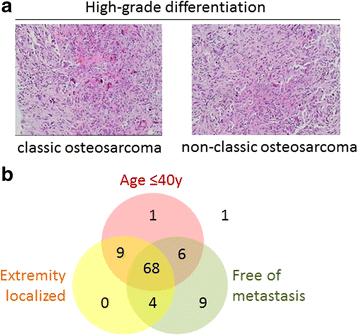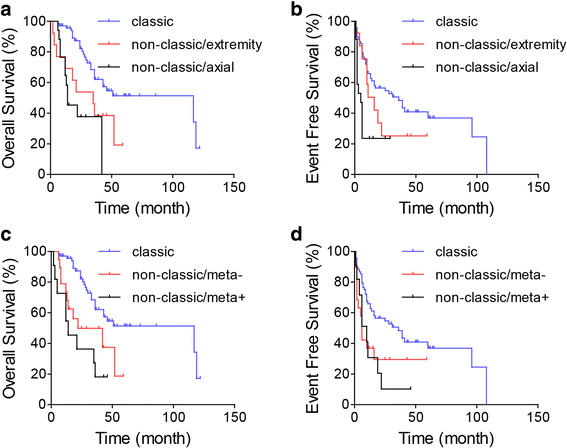The extremity localized classic osteosarcomas have better survival than the axial non-classics
- PMID: 29471883
- PMCID: PMC5824485
- DOI: 10.1186/s12957-018-1344-3
The extremity localized classic osteosarcomas have better survival than the axial non-classics
Abstract
Background: Osteosarcoma is one of the most malignant primary bone cancers, while is rarely reported in China. Of note, very few data of prognosis has been documented in this region. Thus, we carried a retrospective study to identify prognostic factors and to analyze outcomes in patients of both classic and non-classic high-grade osteosarcomas. Classic osteosarcoma is defined as of high-grade histology, age below 40 years, with extremity localized primary tumor, and without detectable metastasis at primary diagnosis.
Methods: A total of 98 patients (68 classic and 30 non-classic) aged from 4 to 64 years old were diagnosed as high-grade osteosarcoma from 2008 to 2015 in Nanfang Hospital, Guangzhou, China. Univariate and multivariate analyses were performed to identify the independent predictors for overall survival and event-free survival. Kaplan-Meier method was used for survival analysis.
Results: The median overall survival was 117 vs. 21 months, and the median event-free survival was 31 vs. 6 months in classic and non-classic osteosarcoma, respectively. The most frequently found tumor site was around the knee. The classic osteosarcoma had better overall survival and event-free survival than the non-classics. Tumor site and primary metastasis were found to be associated with overall survival and event-free survival in the univariate analysis. In the multivariate Cox regression analysis, tumor site and primary metastasis were each verified as independent prognostic factors. However, no similar result was found in elevated serum alkaline phosphatase or lactate dehydrogenase. Amputation or limb salvage surgery had no significant effect on overall survival and event-free survival in the extremity osteosarcomas. Classic osteosarcomas with extremity tumor site and free of primary metastasis exhibited better overall survival and event-free survival, while the axial and metastatic non-classics exhibited the worse.
Conclusions: The extremity classic osteosarcomas have better survivals than the axial non-classic cases. Amputation and limb salvage surgery make no significant change in overall survival and event-free survival in the extremity osteosarcomas.
Trial registration: Nanfang2013071; Date of registration: 7 September 2013 (retrospectively registered).
Keywords: Axial; Event-free survival; Extremity; Osteosarcoma; Overall survival.
Conflict of interest statement
Ethics approval and consent to participate
This study was approved by the Nanfang Hospital Ethics Review Board with the consent of each patient.
Consent for publication
Not applicable.
Competing interests
The authors declare that they have no competing interests.
Publisher’s Note
Springer Nature remains neutral with regard to jurisdictional claims in published maps and institutional affiliations.
Figures



Similar articles
-
Prognostic factors in high-grade osteosarcoma of the extremities or trunk: an analysis of 1,702 patients treated on neoadjuvant cooperative osteosarcoma study group protocols.J Clin Oncol. 2002 Feb 1;20(3):776-90. doi: 10.1200/JCO.2002.20.3.776. J Clin Oncol. 2002. PMID: 11821461 Clinical Trial.
-
Experience of pediatric osteosarcoma of the extremity at a single institution in Taiwan: prognostic factors and impact on survival.Ann Surg Oncol. 2015 Apr;22(4):1080-7. doi: 10.1245/s10434-014-4154-z. Epub 2014 Oct 17. Ann Surg Oncol. 2015. PMID: 25323470 Clinical Trial.
-
Analysis of prognostic factors in 333 Chinese patients with high-grade osteosarcoma treated by multidisciplinary combined therapy.Asia Pac J Clin Oncol. 2013 Mar;9(1):71-9. doi: 10.1111/j.1743-7563.2012.01560.x. Epub 2012 Jul 23. Asia Pac J Clin Oncol. 2013. PMID: 22897971
-
Osteosarcoma: the COSS experience.Cancer Treat Res. 2009;152:289-308. doi: 10.1007/978-1-4419-0284-9_15. Cancer Treat Res. 2009. PMID: 20213397 Review.
-
Pulmonary metastasectomy in primary extremity osteosarcoma: Choosing wisely, along with a brief review of literature.Indian J Cancer. 2020 Apr-Jun;57(2):172-181. doi: 10.4103/ijc.IJC_497_18. Indian J Cancer. 2020. PMID: 32445321 Review.
Cited by
-
Development and validation of a nomogram to predict long-term cancer-specific survival for patients with osteosarcoma.Sci Rep. 2023 Jun 23;13(1):10230. doi: 10.1038/s41598-023-37391-8. Sci Rep. 2023. PMID: 37353555 Free PMC article.
-
Prognostic factors in osteosarcoma: A study level meta-analysis and systematic review of current practice.J Bone Oncol. 2020 Feb 21;21:100281. doi: 10.1016/j.jbo.2020.100281. eCollection 2020 Apr. J Bone Oncol. 2020. PMID: 32140401 Free PMC article.
-
Characteristics, Management, and Outcomes of Patients With Osteosarcoma: An Analysis of Outcomes From the National Cancer Database.J Am Acad Orthop Surg Glob Res Rev. 2022 Feb 22;6(2):e22.00009. doi: 10.5435/JAAOSGlobal-D-22-00009. J Am Acad Orthop Surg Glob Res Rev. 2022. PMID: 35192571 Free PMC article.
-
Machine learning-based CT radiomics features for the prediction of pulmonary metastasis in osteosarcoma.Br J Radiol. 2021 Aug 1;94(1124):20201391. doi: 10.1259/bjr.20201391. Epub 2021 Jun 19. Br J Radiol. 2021. PMID: 34111978 Free PMC article.
-
Prognosis of limb‑salvage treatment of osteosarcoma in adolescent patients: a meta‑analysis.Oncol Lett. 2023 Sep 15;26(5):466. doi: 10.3892/ol.2023.14053. eCollection 2023 Nov. Oncol Lett. 2023. PMID: 37780543 Free PMC article.
References
-
- Nataraj V, Batra A, Rastogi S, Khan SA, Sharma MC, Vishnubhatla S, Bakhshi S. Developing a prognostic model for patients with localized osteosarcoma treated with uniform chemotherapy protocol without high dose methotrexate: a single-center experience of 237 patients. J Surg Oncol. 2015;112:662–668. doi: 10.1002/jso.24045. - DOI - PubMed
-
- Whelan JS, Jinks RC, McTiernan A, Sydes MR, Hook JM, Trani L, Uscinska B, Bramwell V, Lewis IJ, Nooij MA, et al. Survival from high-grade localised extremity osteosarcoma: combined results and prognostic factors from three European Osteosarcoma Intergroup randomised controlled trials. Ann Oncol. 2012;23:1607–1616. doi: 10.1093/annonc/mdr491. - DOI - PMC - PubMed
-
- Link MP, Goorin AM, Horowitz M, Meyer WH, Belasco J, Baker A, Ayala A, Shuster J. Adjuvant chemotherapy of high-grade osteosarcoma of the extremity. Updated results of the Multi-Institutional Osteosarcoma Study. Clin Orthop Relat Res. 1991;270:8–14. - PubMed
Publication types
MeSH terms
Grants and funding
LinkOut - more resources
Full Text Sources
Other Literature Sources
Medical

